1. The document outlines the agenda for a training course on cosmetic product development. It will cover topics like definitions, elementary chemistry, ingredients, formulas, and safety.
2. The trainer, Rob Klerkx, is introduced. He has over 30 years of experience in industries like pharmaceuticals, cosmetics, and food. He will train participants on product development, marketing, quality control and supply chain management.
3. Definitions of key terms are provided, including the etymology of "cosmetic" and legal definitions. Nomenclature standards like INCI are also introduced.
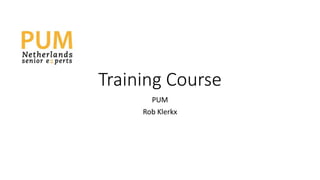

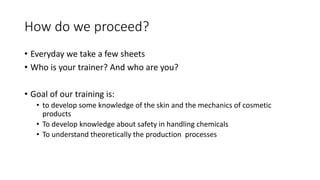
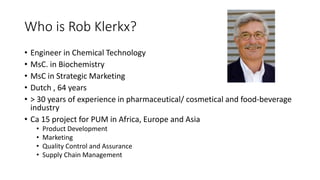

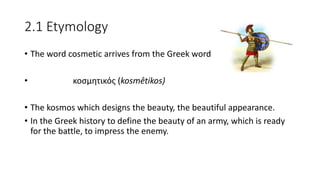
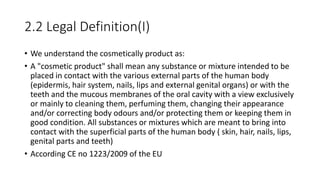

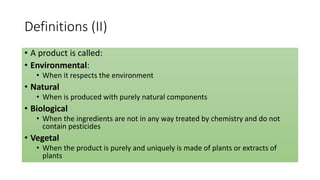
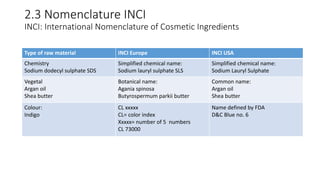
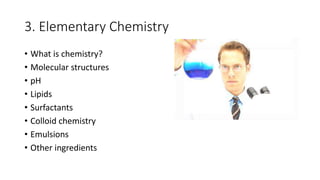
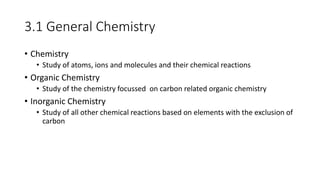

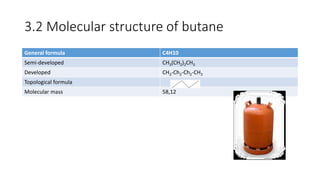
![3.3 Acids and bases
Acid
• Substance which liberates
a proton: H+ in water
• E.g. HCl
Base
• Substance which liberates OH-
ions in water
• E.g. NaOH
• pH= -log[H+]](https://image.slidesharecdn.com/trainingcourse-140724045506-phpapp02/85/Training-course-in-skincare-15-320.jpg)












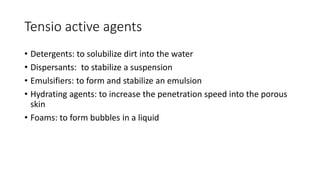








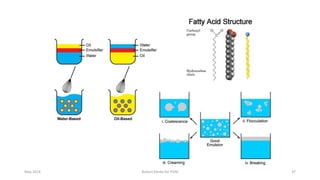
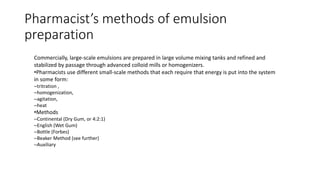
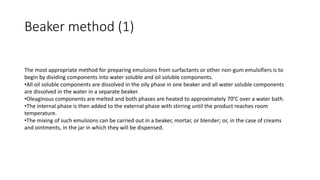




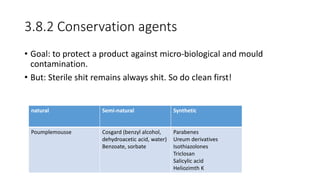







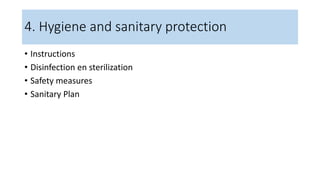





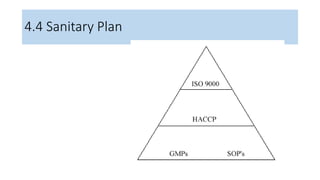


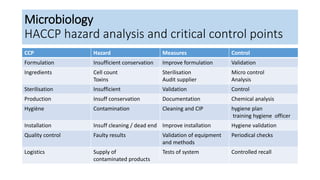



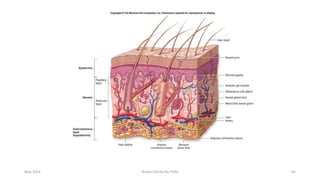
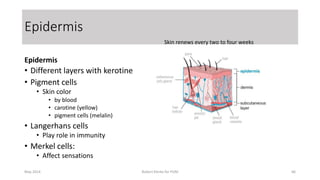






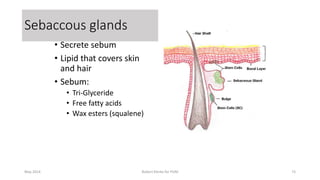


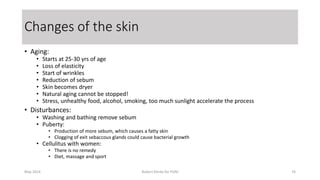








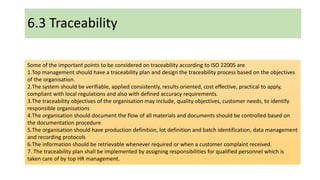








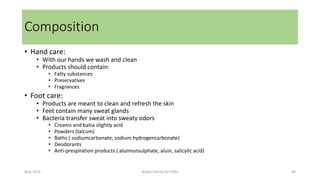
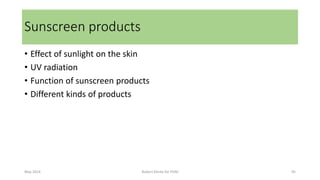

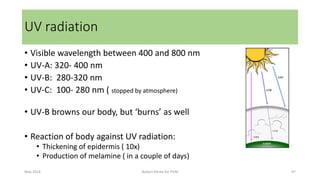


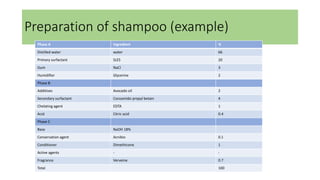
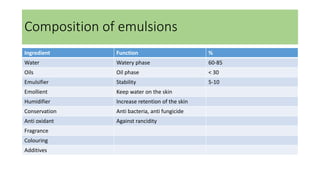
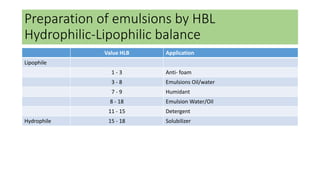
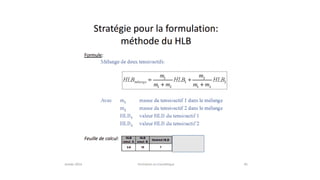
![Aleurites Moluccana Seed Oil [7] Grape (Vitis Vinifera) Seed Oil [7]
Almond Oil NF [6] Hybrid Safflower (Carthamus Tinctorius) Oil [9]
Anhydrous Lanolin USP [10] Isopropyl Myristate [11.5]
Apricot Kernel Oil [7] Isopropyl Palmitate [11.5]
Avocado (Persea Gratissima) Oil [7] Jojoba (Buxus Chinensis) Oil [6.5]
Babassu Oil [8] Lanolin [10]
Beeswax [12] Macadamia (Ternifolia) Nut Oil [7]
Borage (Borago Officinalis) Seed Oil [7] Mangifera Indica (Mango) Seed Butter [8]
Brazil Nut Oil [8] Mineral Oil [10.5]
C12-15 Alkyl Benzoate [13] Myristyl Myristate [8.5]
Cannabis Sativa Seed Oil [7] Olive (Olea Europaea) Oil [7]
Canola Oil [7] Oryza Sativa (Rice Bran) Oil [7]
Caprylic/Capric Triglyceride [5] Peanut Oil NF [6]
Carrot (Daucus Carota Sativa) Seed Oil [6] Petrolatum [7]
Castor (Ricinus Communis) Oil [14] PPG-15 Stearyl Ether [7]
Ceresin [8] Retinyl Palmitate [6]
Cetearyl Alcohol [15.5] Safflower (Carthamus Tinctorius) Oil [8]
Cetyl Alcohol [15.5] Sesame (Sesamum Indicum) Oil [7]
Cetyl Esters [10] Shea Butter (Butyrospermum Parkii) [8]
Cetyl Palmitate [10] Soybean (Glycine Soja) Oil [7]
Coconut Oil [8] Stearic Acid [15]
Daucus Carota Sativa (Carrot) Root Extract [6] Stearyl Alcohol [15.5]
Diisopropyl Adipate [9] Sunflower (Helianthus Annus) Oil [7]
Dimethicone [5] Sweet Almond (Prunus Amygdalus Dulcis) Oil [7]
Dog Rose (Rosa Canina) Hips Oil [7] Theobroma Cacao (Cocoa) Seed Butter [6]
Oils and waxes and their HBL](https://image.slidesharecdn.com/trainingcourse-140724045506-phpapp02/85/Training-course-in-skincare-104-320.jpg)
![Calcium Stearoyl Lactylate [HLB = 5.1 ± 1] Oleth-20 [HLB = 15.3 ± 1]
Ceteareth-20 [HLB = 15.2 ± 1] PEG-100 Stearate [HLB = 18.8 ± 1]
Cetearyl Glucoside [HLB = 11 ± 1] PEG-20 Almond Glycerides [HLB = 10 ± 1]
Ceteth-10 [HLB = 12.9 ± 1] PEG-20 Methyl Glucose Sesquistearate [HLB = 15 ± 1]
Ceteth-2 [HLB = 5.3 ± 1] PEG-25 Hydrogenated Castor Oil [HLB = 10.8 ± 1]
Ceteth-20 [HLB = 15.7 ± 1] PEG-30 Dipolyhydroxystearate [HLB = 5.5 ± 1]
Cocamide MEA [HLB = 13.5 ± 1] PEG-4 Dilaurate [HLB = 6 ± 1]
Glyceryl Laurate [HLB = 5.2 ± 1] PEG-40 Sorbitan Peroleate [HLB = 9 ± 1]
Glyceryl Stearate [HLB = 3.8 ± 1] PEG-60 Almond Glycerides [HLB = 15 ± 1]
Glyceryl Stearate (and) PEG-100 Stearate [HLB = 11 ± 1]
PEG-8 Laurate [HLB = 13 ± 1]
Glyceryl Stearate SE [HLB = 5.8 ± 1] PEG-80 Sorbitan Laurate [HLB = 19.1 ± 1]
Glycol Distearate [HLB = 1 ± 1] Polysorbate 20 [HLB = 16.7 ± 1]
Glycol Stearate [HLB = 2.9 ± 1] Polysorbate 60 [HLB = 14.9 ± 1]
Isoceteth-20 [HLB = 15.7 ± 1] Polysorbate 80 [HLB = 15 ± 1]
Isosteareth-20 [HLB = 15 ± 1] Polysorbate 85 [HLB = 11 ± 1]
Lauramide DEA [HLB = 15 ± 1] Sodium Stearoyl Lactylate [HLB = 8.3 ± 1]
Laureth-23 [HLB = 16.9 ± 1] Sorbitan Isostearate [HLB = 4.7 ± 1]
Laureth-4 [HLB = 9.7 ± 1] Sorbitan Laurate [HLB = 8.6 ± 1]
Lecithin [HLB = 4 ± 1] Sorbitan Oleate [HLB = 4.3 ± 1]
Lecithin [HLB = 9.7 ± 1] Sorbitan Sesquioleate [HLB = 3.7 ± 1]
Linoleamide DEA [HLB = 10 ± 1] Sorbitan Stearate [HLB = 4.7 ± 1]
Methyl Glucose Sesquistearate [HLB = 6.6 ± 1] Sorbitan Stearate (and) Sucrose Cocoate [HLB = 6 ± 1]
Oleth-10 [HLB = 12.4 ± 1] Sorbitan Trioleate [HLB = 1.8 ± 1]
Oleth-10 / Polyoxyl 10 Oleyl Ether NF [HLB = 12.4 ± 1] Stearamide MEA [HLB = 11 ± 1]
Oleth-2 [HLB = 4.9 ± 1] Steareth-2 [HLB = 4.9 ± 1]
Oleth-20 [HLB = 12.4 ± 1] Steareth-21 [HLB = 15.5 ± 1]
Emulsifiers sorted by INCI names](https://image.slidesharecdn.com/trainingcourse-140724045506-phpapp02/85/Training-course-in-skincare-105-320.jpg)



